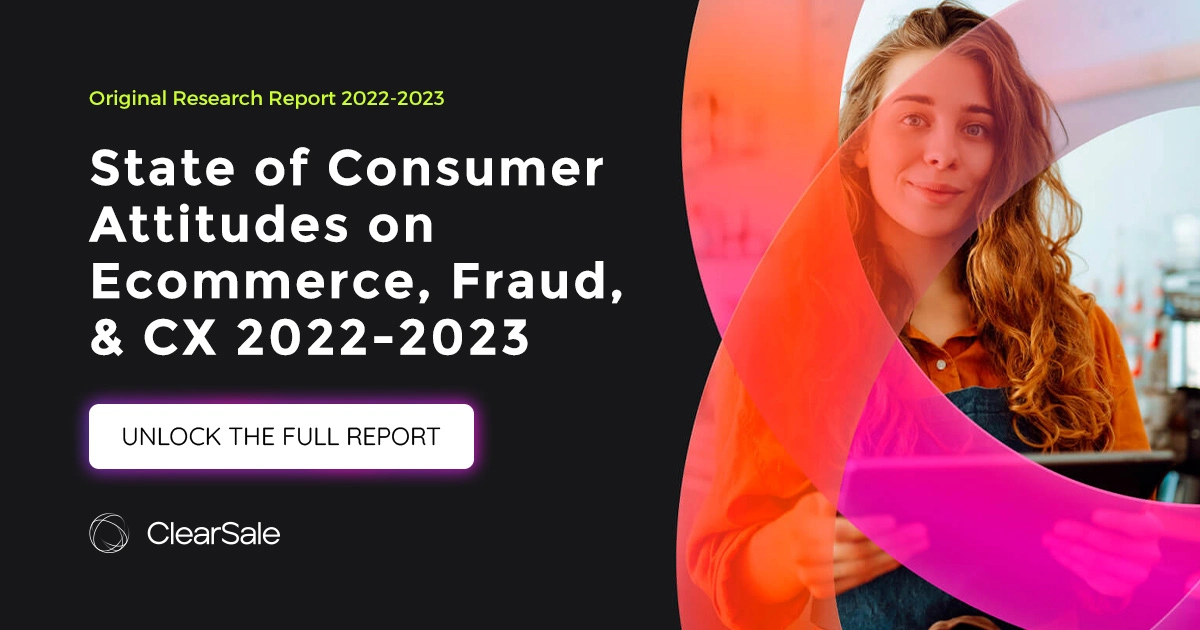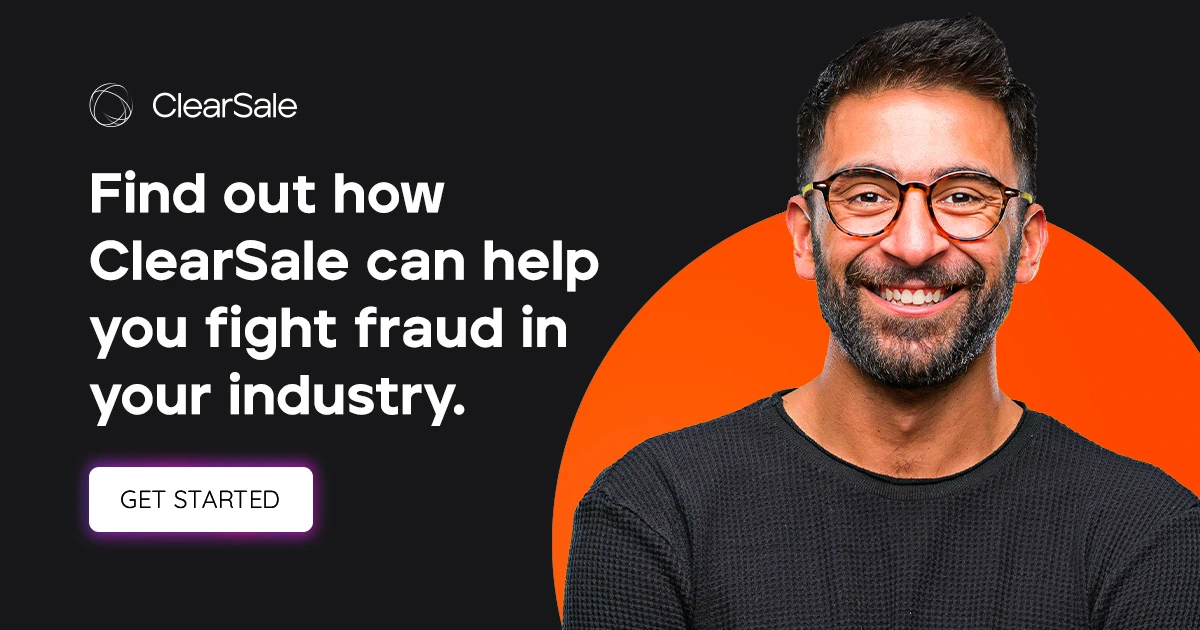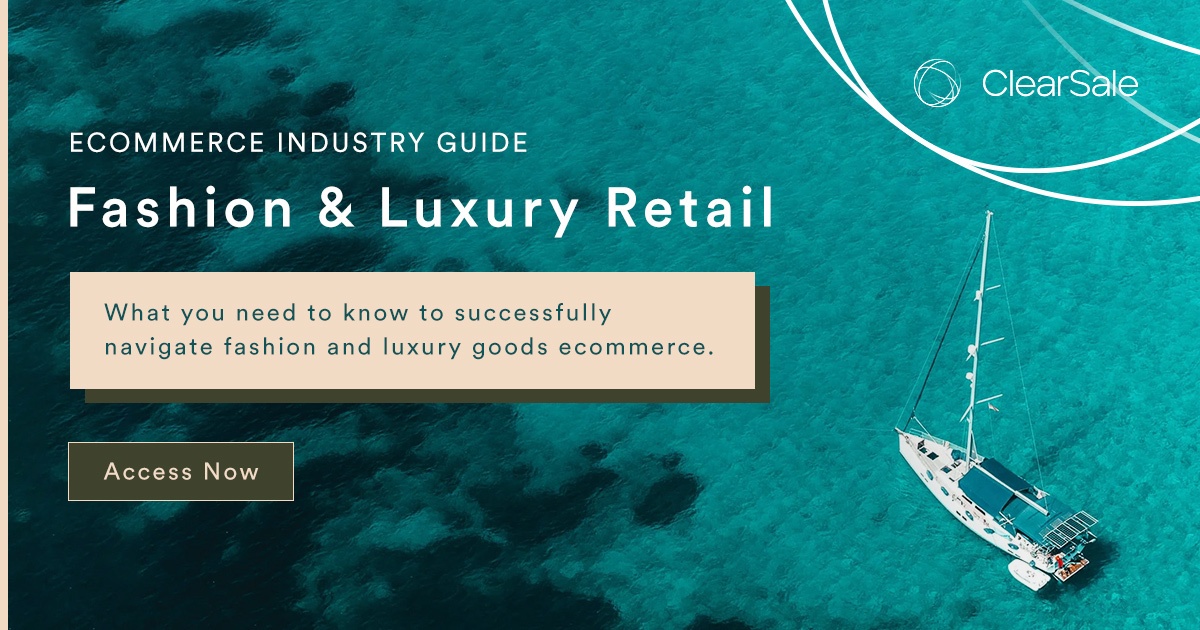Season 2 Episode 11:
Jewelry Ecommerce and CX Insights From Industry Insiders
The post-pandemic jewelry ecommerce industry has shifted considerably — especially relating to how consumers shop, think and behave. That means companies must adapt to consumer behavior, fraud and industry trends if they haven’t already. In particular, we’re seeing marked differences in how generations shop.
That need for instant gratification has those consumers shifting from trying to find the perfect piece of jewelry they want in-store and, instead, searching online for exactly what they’re seeking. It also puts a lot of pressure on online retailers to provide appealing images, detailed descriptions and fast delivery.
In this episode of Gateway to Ecommerce, Faye McEachern, Director of Partnerships at ClearSale interviews Michael Burpoe of Punchmark to discuss how the industry has changed.
LISTEN NOW
EPISODE THOUGHT LEADERS
-

Faye McEachern
is ClearSale’s Director of Partnerships. In her more than 11 years in the ecommerce industry, she’s discovered that businesses often skip the essential research they need to understand who they can partner with for success.
-

Michael Burpoe
is Director Of User Experience at Punchmark. He has managed internal and external product design and execution, architecting new product features and additions for the jewelry industry's leading e-commerce website platform, SiteManager. He also hosts the digital marketing and e-commerce focused weekly podcast, In the Loupe.
PODCAST EPISODE RECAP
FOR YOUNGER GENERATIONS, IT’S ALL ABOUT INSTANT GRATIFICATION
The pandemic advanced online shopping forward significantly, forcing the jewelry industry – which had been primarily in brick-and-mortar stores – to invest in ecommerce solutions. Jewelry store owners were typically tech-adverse and represented by the older generations, so this presented a challenge. Since then, consumers have been able to return to in-person shopping, but younger customers are still expecting ecommerce jewelry brands to have an online presence.
That means they must:
Invest in omnichannel commerce.
Understand that consumers may peruse online, make decisions and then shop in-store.
Appeal to consumers from all generations.
TECHNOLOGY HELPS TO MIMIC THE IN-STORE EXPERIENCE
Technology is making it easier to feature the beauty and individualist nature of jewelry. An online retailer’s website can use this technology to create a customer experience that rivals being in-store. It doesn’t allow for customers to touch and handle the jewelry, but customers can view each piece three-dimensionally and at every angle possible.
Taking it a step further, consumers can use technology to customize jewelry — such as swapping out center stones, changing metal colors and even designing their own pieces. Those options will keep them a browsing online longer and lead to more and more sales.
Stay tuned for upcoming podcast updates and new episodes.
episode Transcript
Intro: Faye McEachern
Welcome back to Gateway to Ecommerce. I'm your host, Faye McEachern, Director of Partnerships at ClearSale. Throughout this podcast, we've talked with ecommerce industry leaders about consumer behavior, online fraud and industry trends, and today is no exception. It's been about a year since we published ClearSale's Fashion and Luxury Goods Guide that addresses the state of ecommerce and online fraud for jewelry and other luxury items. Today, we're going to find out what's changed and what stayed the same from the lovely Michael Burpoe, Director of User Experience with our friends at Punchmark. Welcome, Michael. Thanks for being here. If you could tell our listeners a bit about you and Punchmark, that would be amazing.
Michael Burpoe
Awesome. Hey, Faye. So yes, my name is Michael Burpoe. I'm the Director of User Experience at Punchmark. We work specifically in the jewelry industry. We have tools that allow you to sell diamonds online, which is not something that most other platforms would be well-equipped to handle, but we also allow different integrations — such as with ClearSale — that allow for different better functionality and ways that people can sell online or have it lead to in-store sales as well. So Punchmark also has a digital marketing branch inside of the company, and we are pretty tailored to the jewelry space as well. So, get a really unique slice of luxury and a lot of data that's specifically around the jewelry industry. So we're able to show a weird collection of data points just inside of one vertical.
Faye McEachern
Amazing, amazing. You guys are a wealth of knowledge, and you know we love our partnership with you. So, I am going to launch into some questions for you and put you on the spot. So, the first one that I want to know is we know that jewelry retailers who were traditionally brick and mortar, they had to quickly adapt during the pandemic. And I realize we're talking about the pandemic again, and we always do, but they had to quickly adapt. And so what I really want to know is, "How have they fared since then?"
Michael Burpoe
Yeah, so just to take one step back, yes, the pandemic brought along years and years of change over the course of about two, three months. And for us, that was actually ... Got everybody on board really quickly because for years, I joined Punchmark in 2017, and from 2017 until February of 2020, we were the people that were banging the drums telling everybody, "Hey, you have got to start caring about your online presence. We need you to start being interested in ecommerce because it is a viable way for you to start making more revenue."
And for the longest time, jewelry has always lagged behind in technology, and a lot of the times, that was because our demographics for jewelry store owners typically skew a little bit more tech-adverse as well as maybe a little bit older. So, they weren't ready for that change. However, also because younger people are becoming owners or are taking over management of these websites more and more every day, we did see a massive switch. Now, since then, we are seeing people, they looked up and they're like, "Well, now sales are back in store," and they're like, "Wow, these are actually going great, but we also are still continuing some good sales on our websites and we're doing better than we expected." So, what we saw is, I'm going to use this buzzword a million times because it does explain everything, this term the omnichannel solution. So omnichannel means, I always joke, as above, so below. So as above meaning on the website, it should represent your store, but also in your physical. When I say store, I mean your physical brick and mortar, but also as below, so above. So as below in your store, if you have this new brand that you just became partnered with, you need to have that on your website because what we are seeing is that people will go into stores and then they will go home and then they will purchase or they will go on the website and they will find exactly what they want. They'll create a wish list.
They'll go into the store and then they will purchase. So, it goes back and forth, and we are seeing that ecommerce is becoming increasingly a viable option for a lot of these people. It's not 100%. It's not like people are going to go in … they're going to double the size of their sales purely just by opening up ecommerce and just telling people, "Hey, we're selling jewelry online now." But it has allowed them to get that 5, 10% of growth that they might have been looking for that would really be difficult just by being in store.
Faye McEachern
Absolutely, absolutely. And I'm one of those people. I have to look online before I make a decision and go into the store if that's the route that I have to go. So, follow-up question then to this: Have you found that most of the jewelry retail industry now has a more prominent online presence?
Michael Burpoe
Yes. So, I want to back this one up again. It's not like before, people didn't have websites. It's just the functionality has changed. So what websites were to jewelers before the pandemic was what I called a digital billboard. It told the customer their store hours, their store location, a little bit about the store (such as an about page or meet the staff and an overview of what their collections might be like). But not exactly everything. But now, everybody is buying into it a little bit more with integrating with their point-of-sale system.
For the jewelry industry, that is almost very widely spread is the edge for jewelers, the edge point of sales system, and that has ... The increase of relying on their website and maybe making some sales off of it has gone up quite a bit. So, I'm not going to say that more people have websites. It's that what ... metric do you want to look at? The number of logins or the amount of times that they're checking their website or the amount of times they're updating their website has drastically gone up in recent years.
Faye McEachern
Amazing. Yeah, and you would have to expect that as well. Everything has moved to online since then. So what trends are you noticing in this industry that retailers should note? Like, "Get your pen out, write it down." What are you seeing that they should note?
Michael Burpoe
Yeah, like I said, because we're jewelry-specific, we're not helping people sell couches or anything like that that might change based on couch demand. But we will say with jewelry is that because it's luxury, luxury is by definition a want and not a need. When the economy was questionable at the very end of last year, we saw that in the online, but what we did see is that people were still buying anniversary gifts. People were buying birthday presents and stuff like that. So, one of the trends we saw was average transaction size has gone down, so the average ticket price, but we're seeing more transactions. So, the amount of transacted dollars …
Faye McEachern
Interesting.
Michael Burpoe
… has actually pretty much stayed the same between 2022 and 2023. However, the average transaction size for our platform, I'll give this little tidbit away, this time last year, it was around $560 to even $690, so $700 about in U.S. dollars, and now we're seeing it around $440 to $530. It depends on the month, but what we are seeing again is that the number of transactions is actually up. So, people are checking out, just with cheaper ... I hate using the term cheaper, but less expensive products. So, for example, they're buying more fashion jewelry or more just fine gold jewelry. Gold jewelry, very in right now, as opposed to buying diamond jewelry, which they were maybe last year. I don't know if that's the product of the economy making people a little bit more hesitant about spending their dollars. But what we are seeing is that the trust in buying ecommerce-wise is actually ... it's still there.
Faye McEachern
Yeah, absolutely. That's really interesting that the average order value has gone down, but the transaction count has gone up and it's still all very positive. Really interesting. So, we have a span of four or even five generations of consumers shopping online now. How has that impacted the jewelry ecommerce industry? Are you seeing trends with regards to who's shopping online and what they tend to purchase?
Michael Burpoe
So, it's a little bit... I don't want to make any big broad judgements, because that would take a little bit more time of diving into data. What we are seeing is that, like I said about transactions, it's more within reach and people are more willing to reach for a website to make a purchase. And that is actually true for the demographics that were not already doing that. So, we're not seeing as much of an increase, for example, in millennial or even Gen X purchasing online, because they already were purchasing online. But now what we're seeing is people like baby boomers, so they're probably 55 to 70 now. Is that probably around the age group?
My parents are 64 and 65, so I know that they're boomers, much to their chagrin. But what's funny is whereas my mother would not have bought online before the pandemic, suddenly, she's seen how easy it is to purchase, for example, with Instacart. She loves buying with Instacart, and it made things so much easier during the pandemic. But then you realize later on that just because the reason for going out has shifted from, "Oh, there's this virus out there," to, "Actually, I'm just a little bit lazy and I can make a …”
Faye McEachern
You don't feel like it.
Michael Burpoe
“… purchase. I don't feel like it, and I can get other things done at home while someone shops for me and it's going to cost me $25 or $30 or more, and that's just the cost of time." We are seeing that increase. But on the flip side, we are also seeing that Gen Z is now becoming ... Gen Z has dollars now. As a result, we are seeing that Gen Z is going to become increasingly a power player. And one more thing, I know I'm rambling on this one, but Gen Z, one thing we have absolutely noticed, and this is true across all industries, that Gen Z has a set of values and they care about where their products are coming from. They care about the ethical, is it ethically, of the purchasing of it. They want to know if the product is made in the U.S. or made in somewhere else.
Faye McEachern
Really?
Michael Burpoe
And that is becoming ... A lot of companies that are trying to cater to these younger purchasers … they are starting to include information about their products that talk about, for example, "Every purchase we make, we donate," or "Every purchase we do, we have a carbon offset for the emissions" — things like that. And that has become an increasing shift.
Faye McEachern
Really interesting. So, in this talk about the online jewelry business, what are the biggest challenges that they have to navigate other than marketing to the Gen Z folks?
Michael Burpoe
I can speak for Punchmark specifically. We focused on four main things, and the first one was fraud. So, we are deepening our partnership with ClearSale because fraud can really set back a ... Especially a new-to-online sales company, if they get set back, if they have a bad run in with fraud, you know what I'm talking about, that can sour the entire taste and honestly can make people even want to shut off their ecommerce purchasing ability right there. The second one is going to be photography. Photographing products, especially jewelry, it's a process because not only is it about getting the diamonds to sparkle, but there's a lot of products in there and they're all small and you want to have them out in the display case. So how often are you going to shoot it?
So, we have people dealing with photography. It's always a bit of a process for them. Another one is ADA compliance. So, ADA compliance is for any website, for Americans at least. There's the Americans with Disabilities Act, and we actually just did an episode on this for our podcast all about the ADA. And what that is essentially for a brick-and-mortar store, you need to have a wheelchair ramp or ability to be accessed by a wheelchair. And that is if you're a place of commerce, and that is to allow equal opportunity and for people with limited mobility or certain types of disabilities to still be able to have equal access to these types of things. The same is true for an online place of commerce. So, people might have motor impairments and they might not be able to use a mouse, so they might be using a screen reader or if they're blind, they might be using a screening reader or they might be colorblind and they might have colorblind settings that will allow for them to still be able to see what's going on on the page.
And if you're not building your website to cater to that, you could be at risk of potential lawsuits and stuff like that. So Punchmark, while our websites are ADA compliant out of the box, we wanted to allow people to be able to have a sense of ease when it comes to updating their websites and staying ADA compliant, which is why we partnered with a company, AccessiBe. We're very fond of them, and they have a plugin that works just as well. So those are probably the big three for them. The other one is the omnichannel solution, and that one is just a whole ball of wax of making sure that your point-of-sale system is also speaking to your website and making sure your products are on both, in store and online.
Faye McEachern
Those are some pretty significant challenges, and it sounds like Punchmark has made it very ... I don't want to say easy, but easy for your merchants to be compliant, have things taken care of, be protected from fraud, all of that bundled into one. So that's some nice peace of mind for folks coming to you guys that they can just learn from the experts and hit the ground running.
Michael Burpoe
Well, the number one thing we've learned is that we're going to make the best websites we can. So that's what we do. We're a website platform. We do digital marketing, so that's our expertise in branding. So, we're going to stay in our lane and we want to work with the best companies out there. So, we're not experts on fraud. So, we're going to work with experts on fraud, and that's why we partner with ClearSale. Same thing with, for example, ADA compliance. Our websites, we needed to do a lot of research on what makes a website ADA compliant versus uncompliant, but to get that extra sense of security, we partnered with a company that all they do is ADA compliance and have that accessibility widget in there. So, we just want to work with the best out there.
Faye McEachern
Awesome. So, circling back to present company, in your experience, how have fraud, chargebacks and false declines impacted the jewelry industry?
Michael Burpoe
I alluded to it before. The first one is that if you have a fraud or just a suspicious purchase, I know it's dumb, but some of the older jewelers might be incredulous that someone would be willing to buy 1,000 or 2,000 or several thousand-dollar piece of merchandise product online sight unseen. But we know that that's true. I'm sure people have bought things, bought engagement rings online or you can buy cars online too, but some people are still incredulous and having a fraud or even worse, I think, is a false decline, because then the customer's unhappy and you're unhappy, too.
Faye McEachern
And they go somewhere else.
Michael Burpoe
Then they go somewhere else. So having a bad experience early can sour the entire experience and make it so that people are not willing to go back to ecommerce. But on the other side of it is that, for example, chargebacks, one chargeback is going to set a store's ecommerce profitability back a ton because they are making a markup, but if you were to have something blow up in your face on this kind of thing, it can make it so that they are unprofitable for a spell. And with today's economy, you never know what's going on. It can seriously hit morale and make it so that people, "Oh, why are we even messing around with ecommerce in the first place? We were doing just fine with brick and mortar, so why don't we just go back to what we were doing just fine with?"
Faye McEachern
Totally. Absolutely. So last question here for you: What are the online jewelry retailers doing to create the type of experience that customers expect and want from the industry?
Michael Burpoe
So, this is where that omnichannel experience is coming in. So, for example, if you have an engagement ring, so for jewelry, the engagement ring is the crown jewel of everything related to a jewelry store, because a lot of the times, with that comes a whole host of other purchases. For example, wedding bands, two wedding bands, bridal gifts, grooms gifts, tune-ups. Maybe they want to get a different diamond in the future or a more expensive one. So, we'll just talk about an engagement ring. If you are going into the store to go and shop around, maybe you go with your significant other and you're talking about potentially getting engaged and maybe you want to pick it out together, if then the person who's buying this engagement ring wants to come back and they want to look at it a little bit more, or maybe they want to look into some financing options, if you don't have that set of information and that specific product and everything involved with this purchase on your website as well, then you're going to miss out on that sale or it won't be as easy or the experience won't be as flawless.
But at the same time, we're also seeing that a lot of people (especially men) when they're purchasing engagement rings want to be a little bit secretive about it. So, they are shopping at one o'clock in the morning and they are on their laptops in a dark room, looking at these engagement rings, maybe picking out one. And that is where a website's user experience can come into play and allow people to feel comfortable doing that perusing. And whereas jewelry stores can be intimidating. So, allowing the experience to be where people feel most comfortable and most natural, which, for a lot of people, is on the internet because they spend so much time on the internet. That is why it is increasingly important. And if you're missing out on it, especially on the web, there's no roadblocks. There's no barriers in the way for me to just go to the next website. And that website might not be an independent retailer. It might be a big box store, and I'm always cheering for the retailers to keep winning.
Faye McEachern
That's right. Well, the moment that they go on and that experience isn't somewhat similar to what it would be like in the store, you just move on. You've got to move on to the next one so that you're being sneaky but not for too long.
Michael Burpoe
Yep.
Faye McEachern
Awesome.
Michael Burpoe
So, one more if you don't mind, and I think that I'd recommend this to everybody. This one is a less talked about one. So, with Google right now, Google changes what it is ranking all the time. Back in the day, it was about how much relevant content there was. So, you saw people would pack their websites with all these keywords and now there's other things. So how many reviews your business has has a big importance, and how often people go on there and they actually spend some time on your website. So, all those things are important, and Google is always tweaking what they value. One thing that we know is important right now and has been for a little while and we predict that it will stay important is page speed. So page speed is how quickly your website loads when a customer or a visitor visits your website. And why this is important is that a lot of times, these websites, they've got a lot going on and if your website is taking, for example, 7, 8, 9 seconds to load, that is a bad user experience.
Faye McEachern
Totally.
Michael Burpoe
So, we want your website to load very quickly, and there's a couple different ways that we can get around that, streamlining the process as much as possible. But Punchmark has spent a ton of time of late working on page speed to make sure that your website will load as fast as possible, which Google will then value and rank you higher. So, if you want to see what your website's page speed rank is, you can just go on Google, type in "page speed." It'll be the first one. It's a Google-owned domain, and you can just type in your own website domain, give it a look. You'll probably score somewhere in the thirties or forties, which, don't be alarmed, that's the norm, but it's good to start keeping an eye on it.
Faye McEachern
Very cool. Absolutely. Amazing. As always, Michael, you are an absolute pleasure to work with, total wealth of knowledge, love doing podcasts with you. Now tell me how can folks get ahold of the Punchmark team?
Michael Burpoe
Absolutely. So, the easiest way to get ahold of us is going to be on Punchmark.com. You can see all of our information and if you want to email us, you can also email us at info@punchmark.com and Punchmark, that's P-U-N-C-H-M-A-R-K. And I also run a podcast called “In the Loupe,” which Faye has graciously guested on several times. And loupe is spelled L-O-U-P-E, like the jewelry loupe, and we talk all about digital marketing, ecommerce, specifically around the jewelry industry. And also, we talk just about interesting interviews around the space. I think it's a really fun time. It's my favorite part of my job, and we have new episodes every Tuesday.
Faye McEachern
Awesome. Thanks again, Michael, for coming on the show, and we really appreciate you.
Michael Burpoe
Absolutely. Thank you again, Faye, for having me. Cheers everybody.
Outro: Faye McEachern
If you want to take a deeper dive into this topic, you can visit our website at clear.sale to learn how the online payments process works. It's also linked in the description of this podcast along with another resource to get you started. Thanks again for listening to “Gateway to Ecommerce.” If you like what you heard today, be sure to stay connected. Subscribe or follow on all major platforms, like Apple, Spotify or iHeart. If you have any questions or you'd like us to cover a topic, email us at podcast@clear.sale. We'd love to hear from you. To learn how to prevent ecommerce fraud, visit our website. We have a ton of resources dedicated to this topic that can help you on your ecommerce journey at www.clear.sale. Until next time.






![Cópia de [TEMPLATE] AUDIOGRAM TILES - Season 2 (1)](https://gatewaytoecommerce.clear.sale/hubfs/C%C3%B3pia%20de%20%5BTEMPLATE%5D%20AUDIOGRAM%20TILES%20-%20Season%202%20(1).png)













